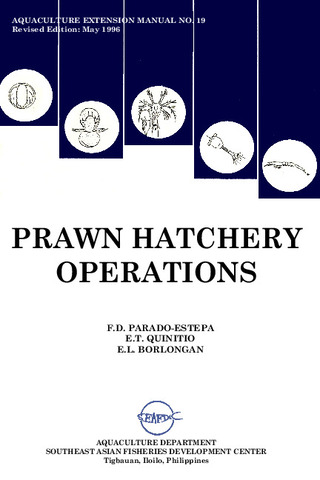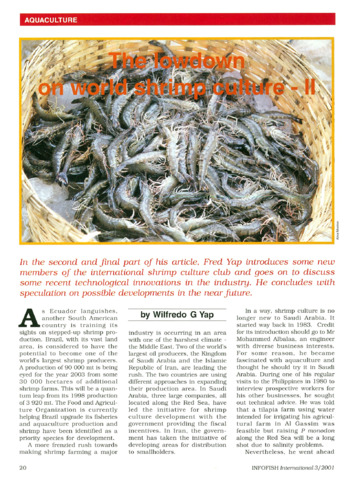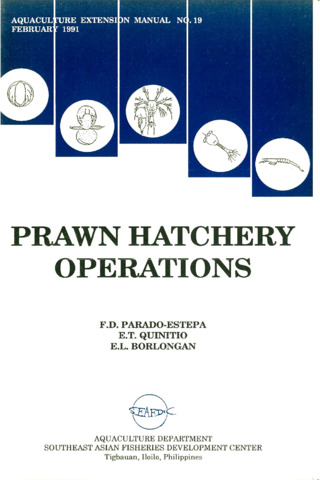Protein and dry matter digestibility of feedstuffs in complete diets for Penaeus monodon
- Global styles
- MLA
- Vancouver
- Elsevier - Harvard
- APA
- Help

View/
Date
1997Author
Page views
5,162ASFA keyword
AGROVOC keyword
Taxonomic term
Metadata
Show full item record
Share
Abstract
The digestibilities of animal and plant protein sources were determined for P. monodon (30 ~ 40 g wet weight). Protein sources were incorporated in complete diets containing the indicator, chromic oxide at 1.8%. Casein, (APDC=97.9%) was highly digested. The APDC values of shrimp meal (Acetes sp.) and squid meal were 95.4% and 96.0%, respectively. These values did not differ from those for plant protein sources such as soybean meal (93.4%), yeast (93.0%) and wheat germ meal (91.9%). Fish meal (60.75%), meat and bone meal (73.8%) and copra meal (75.2%) had significantly lower APDC values while shrimp head meal and testis meal were digested at 89%~90%. Assimilation (U1) of dietary organic matter by the ash-free method ranged from 58.3%~90.19%. The TPDC of feedstuffs were generally higher by about 5% than the APDC. A highly positive correlation was observed between APDC and ADMDC (r=90). Protein content of all diets which ranged from 12.9%~60.18% showed no correlation with APDC, TPDC, ADMDC and U1. This study showed that the shrimp has the capability to similarly digest plant and animal protein sources.
Subjects
Shrimp cultureSuggested Citation
Catacutan, M. R. (1997). Protein and dry matter digestibility of feedstuffs in complete diets for Penaeus monodon. In Y. Zhou, H. Zhou, C. Yao, Y. Lu, F. Hu, H. Cui, & F. Din (Eds.), The Fourth Asian Fisheries Forum: Proceedings of the Fourth Asian Fisheries Forum, Beijing, 16-20 October 1995 (pp. 490–494). Makati City, Philippines: Asian Fisheries Society.
Type
Conference paperISBN
7502743901Collections
- Conference Proceedings [299]
Related items
Showing items related by title, author, creator and subject.
-
Series: Aquaculture extension manual; No. 19
Prawn hatchery operations
Parado-Estepa, Fe D.; Quinitio, Emilia T. ; Borlongan, Emeterio L. (Aquaculture Department, Southeast Asian Fisheries Development Center, 1996-05)
The manual, an updated version of the 1984 SEAFDEC/AQD manual, presents the underlying principles and step-by-step instructions of prawn larval and post-larval rearing. The techniques described are not only applicable to ...
; Borlongan, Emeterio L. (Aquaculture Department, Southeast Asian Fisheries Development Center, 1996-05)
The manual, an updated version of the 1984 SEAFDEC/AQD manual, presents the underlying principles and step-by-step instructions of prawn larval and post-larval rearing. The techniques described are not only applicable to ... -
The lowdown on world shrimp culture - II
Yap, Wilfredo G. (INFOFISH, 2001)This paper introduces some new members of the international shrimp culture club and goes on to discuss some recent technological innovations in the industry, particularly the polyculture of tilapia (mainly Oreochromis ... -
Series: Aquaculture extension manual; No. 19
Prawn hatchery operations
Parado-Estepa, Fe D.; Quinitio, Emilia T. ; Borlongan, Emeterio L. (Aquaculture Department, Southeast Asian Fisheries Development Center, 1991-02)
The manual, an updated version of the 1984 SEAFDEC/AQD manual, presents the underlying principles and step-by-step instructions of prawn larval and post-larval rearing. The techniques described are not only applicable to ...
; Borlongan, Emeterio L. (Aquaculture Department, Southeast Asian Fisheries Development Center, 1991-02)
The manual, an updated version of the 1984 SEAFDEC/AQD manual, presents the underlying principles and step-by-step instructions of prawn larval and post-larval rearing. The techniques described are not only applicable to ...





